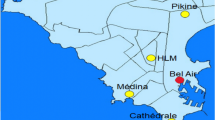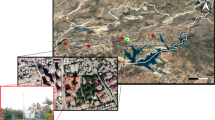Abstract
Fog and associated significant reduced visibility lead to flight cancellation, delay and diversion at IGI airport during the winter months every year. In the present study, a 24-hr and 48-hr fog/visibility forecast with value addition method has been implemented at IGI airport during the months of December and January, 2020–2021. The meteorological parameters information related to fog is obtained from IMD-GFS model outputs. A detailed forecast verification has also been carried out using the METAR and synoptic observations. Results indicated that the 24-hr fog/visibility forecast has promising skill score with a hit rate of 0.92 and Critical Success Index (CSI) of 0.68, whereas the false alarm ratio (0.28) is quite low. This indicates that the method has reasonable predictive accuracy and can be used for fog/visibility forecasting at regional scale. However, the 48-hr forecast scheme performance needs to be improved. In addition, detailed analysis has also been performed on various surface meteorological parameters such as wind speed and relative humidity during the period and the results were in agreement with the fog/visibility observations in most of the cases. In future, the current fog/visibility forecasting method would be further improved with increased robustness of the models used and also be objective.





Similar content being viewed by others
References
Arun S H, Sharma S K, Chaurasia S, Vaishnav R and Kumar R 2018a Fog/low clouds detection over the Delhi Earth Station using the Ceilometer and the INSAT-3D/3DR satellite data; Int. J. Remote Sens. 39(12) 4130–4144.
Arun S H, Chaurasia S, Misra A and Kumar R 2018b Fog stability index: A novel technique for fog/low clouds detection using multi-satellites data over the Indo-Gangetic plains during winter season; Int. J. Remote Sens. 39(22) 8200–8218.
Bergot T and Koracin D 2021 Observation, simulation and predictability of fog: Review and perspectives; Atmosphere 12(2) 235, https://doi.org/10.3390/atmos12020235.
Bendix J and Bachmann M 1991 Ein operational einsetzbares Verfahren zur Nebelerkennung auf der Basis von AVHRR-Daten der NOAA-Satelliten; Meterol. Rundsch. 43(6) 169–178.
Bendix J, Cermak J and Thies B 2004 New perspectives in remote sensing of fog and low stratus-TERRA/AQUA-MODIS and MSG; In: Third International Conference on Fog, Cape Town 11(15.10).
Bhowmik S K R, Sud A M and Singh C 2004 Forecasting fog over Delhi – An objective method; Mausam 55(2) 313–322.
Bhushan B, Trivedi H K N, Bhatia R C, Dube R K, Giri R K and Negi R S 2003 On the persistence of fog over northern parts of India; Mausam 54(4) 851–860.
Chaurasia S, Sathiyamoorthy V, Paul Shukla B, Simon B Joshi and Pal P K 2011 Night-time fog detection using MODIS data over Northern India; Meteorol. Appl. 18(4) 483–494.
Choudhury S, Rajpal H, Saraf A K and Panda S 2007 Mapping and forecasting of North Indian winter fog: An application of spatial technologies; Int. J. Remote Sens. 28(16) 3649–3663.
Dey S 2018 On the theoretical aspects of improved fog detection and prediction in India; Atmos. Res. 202 77–80.
Dhangar N G, Lal D M, Ghude S D, Kulkarni R, Parde A N, Pithani P, Niranjan K, Prasad D S, Jena C, Sajjan V S and Prabhakaran T 2021 On the conditions for onset and development of fog over New Delhi: An observational study from the WiFEX; Pure Appl. Geophys. 178(9) 3727–3746.
Dutta D and Chaudhuri S 2015 Nowcasting visibility during wintertime fog over the airport of a metropolis of India: Decision tree algorithm and artificial neural network approach; Nat. Hazards (Dordr) 75(2) 1349–1368.
Ellrod G P 1995 Advances in the detection and analysis of fog at night using GOES multispectral infrared imagery; Wea. Forecast. 10(3) 606–619.
Ghude S D, Bhat G S, Prabhakaran T, Jenamani R K, Chate D M, Safai P D, Karipot A K, Konwar M, Pithani P, Sinha V and Rao P S P 2017 Winter fog experiment over the Indo-Gangetic plains of India; Curr. Sci. 112(4) 767–784.
Goswami P and Sarkar S 2017 An analogue dynamical model for forecasting fog-induced visibility: Validation over Delhi; Meteorol. Appl. 24(3) 360–375.
Goswami S, Chaudhuri S, Das D, Sarkar I and Basu D 2020 Adaptive neuro-fuzzy inference system to estimate the predictability of visibility during fog over Delhi, India; Meteorol. Appl. 27(2) 1900.
Guijo-Rubio D, Gutiérrez P A, Casanova-Mateo C, Sanz-Justo J, Salcedo-Sanz S and Hervás-Martínez C 2018 Prediction of low-visibility events due to fog using ordinal classification; Atmos. Res. 214 64–73.
Gultepe I, Pagowski M and Reid J 2007 A satellite-based fog detection scheme using screen air temperature; Wea. Forecast. 22(3) 444–456.
Hunt G E 1973 Radiative properties of terrestrial clouds at visible and infra-red thermal window wavelengths; Quart. J. Roy. Meteorol. Soc. 99(420) 346–369.
Jayakumar A, Rajagopal E N, Boutle I A, George J P, Mohandas S, Webster S and Aditi S 2018 An operational fog prediction system for Delhi using the 330 m Unified Model; Atmos. Sci. Lett. 19(1) e796.
Jayakumar A, Gordon H, Francis T, Hill A A, Mohandas S, Sandeepan B S, Mitra A and Beig G 2021 Delhi model with chemistry and aerosol framework (DM-Chem) for high-resolution fog forecasting; Quart. J. Roy. Meteorol. Soc., https://doi.org/10.1002/qj.4163.
Jenamani R K 2012 Development of intensity based fog climatological information system (daily and hourly) at IGI airport, New Delhi for use in fog forecasting and aviation; Mausam 63(1) 89–112.
Kulkarni R, Jenamani R K, Pithani P, Konwar M, Nigam N and Ghude S D 2019 Loss to aviation economy due to winter fog in New Delhi during the winter of 2011–2016; Atmosphere 10(4) 198.
Kutty S G, Agnihotri G, Dimri A P and Gultepe I 2019 Fog occurrence and associated meteorological factors over Kempegowda International Airport, India; Pure Appl. Geophys. 176(5) 2179–2190.
Lee T F, Turk F J and Richardson K 1997 Stratus and fog products using GOES-8–9 3.9-μm data; Wea. Forecast. 12(3) 664–677.
Mitra A K, Nath S and Sharma A K 2008 Fog forecasting using rule-based fuzzy inference system; J. Indian Soc. Remote Sens. 36(3) 243–253.
Mohapatra M and Thulasi Das A 1998 Analysis and forecasting of fog over Bangalore airport; Mausam 49 135–142.
Payra S and Mohan M 2014 Multirule based diagnostic approach for the fog predictions using WRF modelling tool; Adv. Meteorol., https://doi.org/10.1155/2014/456065.
Pithani P, Ghude S D, Chennu V N, Kulkarni R G, Steeneveld G J, Sharma A, Prabhakaran T, Chate D M, Gultepe I, Jenamani R K and Madhavan R 2019 WRF model prediction of a dense fog event occurred during the winter fog experiment (WIFEX); Pure Appl. Geophys. 176(4) 1827–1846.
Pithani P, Ghude S D, Jenamani R K, Biswas M, Naidu C V, Debnath S, Kulkarni R, Dhangar N G, Jena C, Hazra A and Phani R 2020 Real-time forecast of dense fog events over Delhi: The performance of the WRF model during the WIFEX field campaign; Wea. Forecast. 35(2) 739–756.
Saraf A K, Bora A K, Das J, Rawat V, Sharma K and Jain S K 2011 Winter fog over the Indo-Gangetic Plains: Mapping and modelling using remote sensing and GIS; Nat. Hazards (Dordr) 58(1) 199–220.
Singh C 2011 Unusual long and short spell of fog conditions over Delhi and northern plains of India during December–January 2009–2010; Mausam 62(1) 41–50.
Singh H and Dhattarwal S K 2004 Pattern and distribution of injuries in fatal road traffic accidents in Rohtak (Haryana); J. Indian Acad. Forensic Med. 26(1) 20–23.
Singh R K and Suman S K 2012 Accident analysis and prediction of model on national highways; Int. J. Civ. Eng. Technol. 1(2) 25–30.
Singh A, George J P and Iyengar G R 2018 Prediction of fog/visibility over India using NWP Model; J Earth Sci. 127(2) 1–13.
Srivastava S K, Sharma A R and Sachdeva K 2017 An observation-based climatology and forecasts of winter fog in Ghaziabad, India; Weather 72(1) 16–22.
Acknowledgements
The authors are thankful to Dr Mrutyunjay Mohapatra, Director General of Meteorology, India Meteorological Department for providing his encouragement and support to carry out the present study. The authors express their sincere gratitude to all Met officials at IGI airport, New Delhi for their enormous support throughout the study.
Author information
Authors and Affiliations
Contributions
ASH: Conceptualization, formal analysis, investigation, methodology, validation, visualization and writing original draft. CS: Conceptualization, formal analysis, supervision and writing – review and editing. SJ: Visualization and writing – review and editing. SKD: Software. DKS: Validation. NN, CST and GK: Supervision.
Corresponding author
Additional information
Communicated by Suresh Babu
Rights and permissions
About this article
Cite this article
Arun, S.H., Singh, C., John, S. et al. A study to improve the fog/visibility forecast at IGI Airport, New Delhi during the winter season 2020–2021. J Earth Syst Sci 131, 124 (2022). https://doi.org/10.1007/s12040-022-01874-5
Received:
Revised:
Accepted:
Published:
DOI: https://doi.org/10.1007/s12040-022-01874-5




